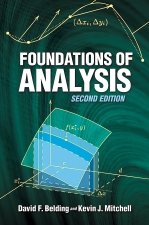
Foundations of Analysis, Second Edition by Dover Publications (ISBN-10: 048646296X, ISBN-13: 978-0486462967). It was originally published by Prentice-Hall (Pearson Education, Inc., ISBN 013326679-6). This is a revised, corrected edition with different pagination.
This text is an introduction to basic analysis. It presents a careful development of the real number system and the theory of calculus on the real line followed by extensions of the theory to the real and the complex planes. The text is designed to be a first encounter with rigorous, formal mathematics for serious mathematics students with a year of calculus. A desire to investigate how calculus is put together and what makes it tick is the primary prerequisite for reading this book. Among the text's student-friendly features are extended discussions of key ideas, detailed proofs of difficult theorems, and reinforcement of basic ideas through repeated exposure to them in different contexts.
Foundations of Analysis has been used for more than a decade in a course at Hobart and William Smith Colleges. The course has calculus and linear algebra as prerequisites and is generally taken by sophomores and juniors.
Table of Contents:
- Chapter 1: The Real Number System
- Chapter 2: Functions, Limits, and Continuity
- Chapter 3: Differentiation and Integration
- Chapter 4: Sequences and Series
- Chapter 5: Calculus in Two Dimensions
- Chapter 6: Line Integrals and Green's Theorem
- Chapter 7: Complex Analysis
Foundations of Analysis is available from Dover Publications or from Amazon.com.
From the Preface:
A firm understanding of basic analysis requires more than a single exposure to the important ideas. This text is designed to present the central concepts of calculus several times in a parallel fashion in different contexts. For example, limits, derivatives and integrals are developed in three settings: functions of one variable, functions of two variables, and functions of a complex variable. Axiom systems are introduced for the real number system in Chapter 1, encountered again in Chapter 5 with vector spaces, and a third time in Chapter 7 with complex numbers. Prepartion for the difficult concept of uniformity starts in Chapter 1 with the Heine--Borel Theorem. It is fully introduced in the definition of uniform continuity in Chapter 2 and used at various points thereafter. The related idea of uniform convergence of functions is an important theme in Chapter 4. Green's Theorem is developed as an extension of the Fundamental Theorem of Calculus and then employed to prove Cauchy's Theorem in Chapter 7. This integrated approach featuring repeated encounters from different perspectives is designed to reinforce and enrich the readers understanding of the fundamental concepts of analysis. It is also intended to demonstrate the unity and power of analysis and afford a more secure and meaningful preparation for later analysis courses.
The awareness of mathematics as a living subject frequently is lost in formal presentations. In this text we have tried to keep that spirit alive. The evolution of the central ideas is discussed from the perspective of mathematicians struggling to forge important concepts and definitions. Several historically important applications are presented which hightlight the roots and connections of analysis to other disciplines. Our intention thoughout the text is to engage the reader in the process of creating mathematics, in thinking through arguments.
This text does not pretend to be a comprehensive treatment of basic analysis and instructors are likely to find various favorite topics missing. Instead, we have tried to present the main current of analysis faithfully and with enough spirit to inspire the student to explore further.
The Authors:
David Belding (belding@hws.edu)
Kevin Mitchell (mitchell@hws.edu, people.hws.edu/mitchell/index.html)
Department of Mathematics and Computer Science
Hobart and William Smith Colleges
Geneva, NY 14456